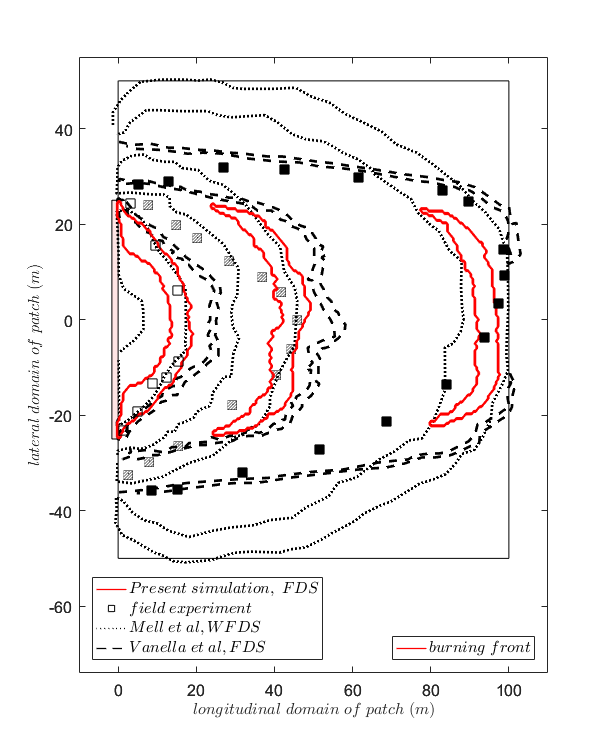Kinetic properties of CSIRO grass fire
Khalid Moinuddin
E = 60300.
Randy McDermott
--
You received this message because you are subscribed to the Google Groups "FDS and Smokeview Discussions" group.
To unsubscribe from this group and stop receiving emails from it, send an email to fds-smv+u...@googlegroups.com.
To view this discussion on the web visit https://groups.google.com/d/msgid/fds-smv/6cbf9b9a-041e-4a5b-854c-a766928329d3n%40googlegroups.com.
Khalid Moinuddin
Thanks, Randy.
By putting all fire properties (kinetic, flammability and thermal) of Morvan_TGA_2.fds, reducing NU to 0.17 and setting DRAG_COEFFICIENT to 8 ( = 1/0.125) – I could get results for C064_BFM close to Moinuddin et al (IJWF, 2018) and hence close to experimental results.
Further fine-tuning of fire properties can lead to a better agreement. As the fire properties of the actual grass species were not measured, fine-tuning can be a sensible option (unless we measure properties for one type of kerosene grasses).
From: fds...@googlegroups.com <fds...@googlegroups.com>
On Behalf Of Randy McDermott
Sent: Monday, 10 October 2022 11:42 AM
To: fds...@googlegroups.com
Subject: Re: [fds-smv] Kinetic properties of CSIRO grass fire
EXTERNAL EMAIL: Please be cautious before clicking on any links or downloading attachments.
To view this discussion on the web visit https://groups.google.com/d/msgid/fds-smv/CAC6wax1spYu1bQN%3D1o4%2BwD27CUnYioMP2SKNqVa0a01d1jNFdw%40mail.gmail.com.
Kevin
Using a Fine-Scale Physical Model. Numerical Heat Transfer, Part A, 47:571–591, 2005.
Khalid Moinuddin
 Not sure how Vanella et al got grid convergence with such course resolution.
Not sure how Vanella et al got grid convergence with such course resolution.&REAC FUEL='FUEL VAPOR', C=3.4, H=6.2, O=2.5, SOOT_YIELD=0.008, HEAT_OF_COMBUSTION=16400., IDEAL=T /
&SPEC ID='WATER VAPOR' /
&MATL ID = 'GENERIC VEGETATION'
DENSITY = 512.
CONDUCTIVITY = 0.1
SPECIFIC_HEAT_RAMP = 'c_v'
A = 3.88E+06
E = 8.79E+04
NU_SPEC = 0.7
SPEC_ID = 'FUEL VAPOR'
NU_MATL = 0.3
MATL_ID = 'CHAR'
HEAT_OF_REACTION = 418. /
&MATL ID = 'CHAR'
DENSITY = 150.
CONDUCTIVITY = 0.052
SPECIFIC_HEAT_RAMP = 'cp_char'
N_S = 1.
N_O2 = 1.
GAS_DIFFUSION_DEPTH = 0.001
SPEC_ID = 'PRODUCTS','AIR'
NU_SPEC = 8.18,-7.2
MATL_ID = 'ASH'
NU_MATL = 0.02
HEAT_OF_REACTION = -32000.
A = 2.25E+01
E = 5.30E+04 /
&MATL ID = 'ASH'
DENSITY = 5.
CONDUCTIVITY = 0.1
SPECIFIC_HEAT = 2.0 /
&RAMP ID='c_v', T= 0., F=1.0 /
&RAMP ID='c_v', T= 25., F=1.0 /
&RAMP ID='c_v', T=125., F=2.0 /
&RAMP ID='c_v', T=175., F=2.4 /
/&RAMP ID='cp_dry_veg', T= 0., F=1.18 /
/&RAMP ID='cp_dry_veg', T= 1000., F=4.81 /
&RAMP ID='cp_char', T= 27, F=0.715 /
&RAMP ID='cp_char', T= 1724, F=2.04 /
